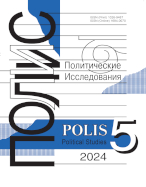Russia and China in Greater Eurasia
Lukin A.V.,
Director, Center for East Asian and SCO Studies, Institute for International Studies, MGIMO University; Professor, National Research University Higher School of Economics, a.lukin@inno.mgimo.ru
elibrary_id: 696524 | ORCID: 0000-0002-1962-2892 | RESEARCHER_ID: L-4986-2015
DOI: 10.17976/jpps/2020.05.04
Lukin A.V. Russia and China in Greater Eurasia. – Polis. Political Studies. 2020. No. 5. https://doi.org/10.17976/jpps/2020.05.04
This work was funded by MGIMO-University, project number 1921-01-02
China and Russia are the main driving forces of Eurasian integration. Russia pursues its “pivot to Asia” while China by its Belt and Road Initiative (BRI) is moving to the West. The interests of Russia and China met in Eurasia and their friendly relations led to several projects of cooperation there. The most important of these are the process of linkage between Eurasian Economic Union and Silk Road Economic Belt Initiative and the plan to create a broader Eurasian Economic Partnership or Greater Eurasia. The Eurasian orientation was a result of a long and painful process of intellectual evolution of the Russian elite caused by realization that the West will never accept Russia as an equal and independent partner. No Moscow leader after Mikhail Gorbachev was originally anti-Western. Gorbachev, Yeltsin and Putin all tried a Western oriented policy first and at a later stage became disillusioned in it. This article studies the reasons which led the two countries to intensify their cooperation in Eurasia, its current state and prospects for the future.
References
Denisov I., Kazantsev A., Lukyanov F., Safranchuk I. 2019. Shifting Strategic Focus of BRICS and
Great Power Competition. – Strategic Analysis. Vol. 43. No. 6. P. 487-498. https://doi.org/10.1080/09700161.2019.1669888
Denisov I., Safranchuk I. 2016. Four Problems of the SCO in Connection with Its Enlargement. – Russian Politics and Law. Vol. 54. P. 5-6, 494-515. https://doi.org/10.1080/10611940.2016.1296304
Khaydarov A., Mirkasymov S. 2019. Uzbek Perspectives on Eurasia. – India Quarterly. Vol. 75. No. 1. P. 94-99. https://doi.org/10.1177/0974928418821469
Li Y. 2018. The greater Eurasian partnership and the Belt and Road Initiative: Can the two be linked? – Journal of Eurasian Studies. Vol. 9. No. 2. P. 94-99. https://doi.org/10.1016/j.euras.2018.07.004
Li Z. 2017. The Greater Eurasian Partnership: Remodeling the Eurasian Order? – China International Studies. March 20. P. 46-65.
Lukin A. 2018. China and Russia: The New Rapprochement. Polity: Cambridge.
Lukin A., Torkunov A. 2020. Trump’s Policies and the Sino-Russian Entente. – Survival: Global Politics and Strategy. Vol. 62. No. 2. P. 27-36. https://doi.org/10.1080/00396338.2020.1739946
Mackinder H. 1904. The Geographical Pivot of History. – The Geographical Journal. Vol. 23. No. 4. P. 421-437. https://doi.org/10.2307/1775498
Purushothaman U., Unnikrishnan N. 2019. A Tale of Many Roads: India’s Approach to Connectivity Projects in Eurasia. – India Quarterly. Vol. 75. No. 1. P. 69-86. https://doi.org/10.1177/0974928418821488
Spykman N. 1942. America’s Strategy in World Politics: The United States and the Balance of Power. New York, Harcourt: Brace and Company.
Zhao H. 2018. Greater Eurasian Partnership: China’s Perspective. – China International Studies. No. 68. P. 68-84.
Brzezinski Z. 2016. The Grand Chessboard: American Primacy and Its Geostrategic Imperatives. (Russ. ed.: Brzezinski Z. Velikaya shakhmatnaya doska: gospodstvo Ameriki i ego geostrategicheskie imperativy. Moscow: AST. 702 p.)
Frolov A. 2016. “Centers of Power” and Multipolarity: a Look through Time. – The International Affairs. No. 11. P. 106-121. (In Russ.)
Karaganov S. 2018. We Have Exhausted the European Pantry. – Russia in Global Affairs. (In Russ.) URL: https://globalaffairs.ru/articles/my-ischerpali-evropejskuyu-kladovuyu/ (accessed 06.04.2020).
Kissinger H. 2018. Diplomacy. (Russ. ed.: Kissinger H. Diplomatiya. Moscow: Ladomir).
Surkov V. 2018. Loneliness of the Half-Blood. – Russia in Global Affairs. (In Russ.) URL: https://globalaffairs.ru/articles/odinochestvo-polukrovki-14/ (accessed 06.04.2020)
Trenin D. 2015. Ot Bol’shoi Evropy k Bol’shoi Azii? Kitaisko-rossiiskaya Antanta [From Greater Europe to Greater Asia? Sino-Russian Entente]. Moscow: Moscow Carnegie Center.
Zhao Huasheng. 2019. Indo-Pacific Strategy and Greater Eurasia: Understanding and Response. – Guojiwenti yanjiu. No. 2. P. 27-46. (In Chinese).
赵华胜, 印台战略与大欧亚:分析与应对, 国际问题研究, 2, 2019年, 27-46.
See also:
Zabella A.A.,
Belt and Road Initiative and the African continental free trade area. – Polis. Political Studies. 2024. No1
Korybko A., Morozov V.M.,
Pakistan’s Role In Russia’s Greater Eurasian Partnership. – Polis. Political Studies. 2020. No3
Lebedeva M.M., Kuznetsov D.A.,
Transregional Integration as a New Phenomenon of World Politics: Nature and Prospects. – Polis. Political Studies. 2019. No5
Zabella A.A.,
Major power rivalry in Africa: a view from China. – Polis. Political Studies. 2022. No1
Lukin A.V.,
Discussion on the Development of China and Prospects for Its Foreign Policy. – Polis. Political Studies. 2019. No1





.jpg)






 print
print
.jpg)
.jpg)